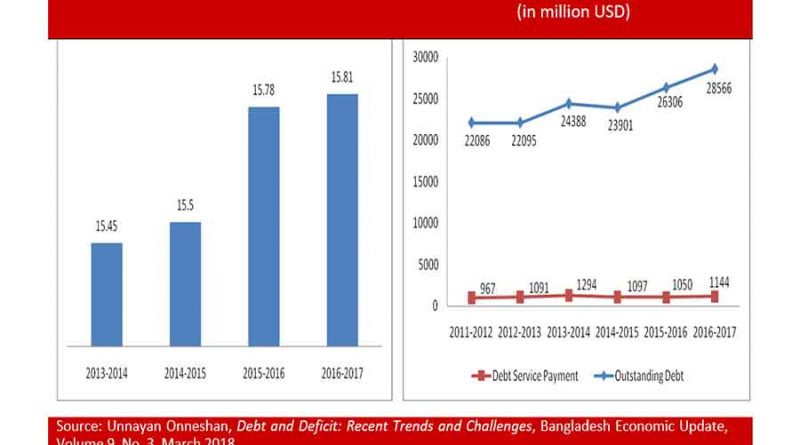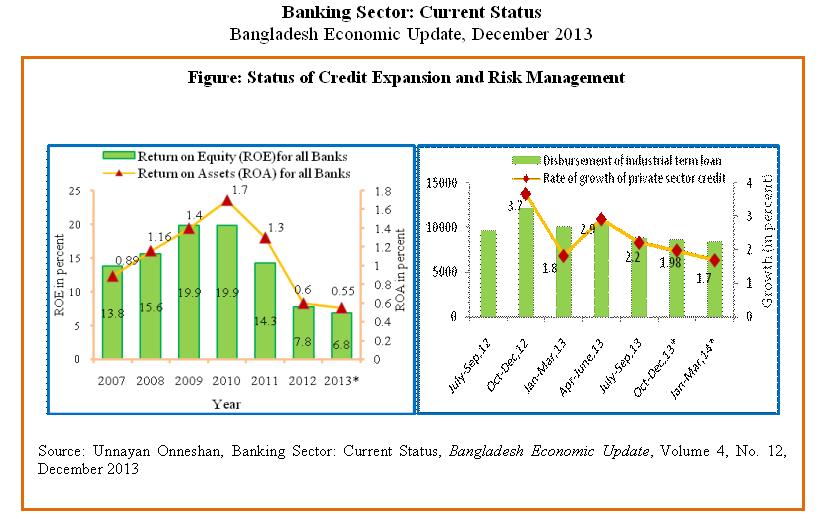Debt & Deficit: Recent Trends & Challenges of Bangladesh Economy
The Unnayan Onneshan (UO), an independent multidisciplinary think-tank, in its monthly publication of the ‘Bangladesh Economic Update’ March 2018, reveals that persistently increasing outstanding debt along with high debt-service payment every year is likely to lower development finance and escalate intergenerational debt burden.
The research organisation notes that at the end of FY 2016-17, the total outstanding domestic debt increased by 15.12 percent while the total outstanding external debt burden rose by 8.59 percent.
During the period of July-December of FY 2017-18, the total outstanding domestic debt increased by 15.32 percent compared to the corresponding period of FY 2016-17. On the other hand, the rate of growth in net foreign aid decreased to 2.10 percent in FY 2016-17 from 17.54 percent in FY 2015-16.
The debt-gross domestic product (GDP) ratio is on the rise since FY 2013-14. Statistics suggest that the outstanding domestic debt as a percentage of GDP was 15.45 percent in FY 2013-14, 15.5 percent in FY 2014-15, 15.78 percent in FY 2015-16, and 15.81 percent in FY 2016-17.
In the first six months of the current fiscal year (July-December of FY 2017-18), the debt-GDP ratio has increased to 14.65 percent compared to 14.30 percent in the corresponding period of FY 2016-17.
The outstanding domestic debt stood at Tk. 325849.84 crores in July-December period of the current fiscal year compared to Tk. 282555.42 crore in the corresponding period of the previous fiscal year. In addition, the year-end amount of outstanding domestic debt almost tripled during the period from FY 2009-10 (Tk. 116823.84 crores) to FY 2016-17 (Tk. 309681.87 crores), finds the research organization.
The outstanding external debt, which is currently 12 percent of GDP in the country, has exhibited a significant increase in the previous fiscal year. Statistics from the Economic Relations Divisions of the Ministry of Finance demonstrate that year-end outstanding external debt increased to USD 28566 million in FY 2016-17 from USD 26306 million in FY 2015-16.
Interest payment on the external debt has increased of late while the total debt-service payment has experienced a fluctuation. The total debt-service payment stood at USD 967 million in FY 2011-12, which increased to USD 1294 million in FY 2013-14, then declined to USD 1050 million in FY 2015-16, and again increased to USD 1144 million in FY 2016-17. Interest payment, on the other hand, increased from USD 202 million in FY 2015-16 to USD 231 million in FY 2016-17.
In terms of debt sustainability, the UO evinces that the outstanding external debt represents 53.49 percent of the total amount of export earnings and remittance in FY 2015-16, whereas this ratio was 48.68 percent in FY 2014-15. In addition, total external debt-service payment represents 3.1 percent of total export earnings and 2.15 percent of the total amount of export earnings and remittance in FY 2015-16.
In financing increased deficit, the target of government borrowing in the budget of FY 2017-18 increases to Tk. 106772 crore, which was Tk. 93,980 crore in the revised budget for FY 2016-17, finds the think tank.
Increasing government borrowing from the domestic sources primarily through the sale of the national saving certificate, i.e. Tk. 39169 crore during July-December period of FY 2017-18 which is 16.08 percent higher than that in the corresponding period of the FY 2016-17, reflects sluggish demand for investible funds in the private sector resulting in stagnant investment in the sector, comments the research organisation.
Increasing allocation for non-development expenditure due to high debt-service payments every year does not allow the government to allocate adequately for annual development programme (ADP), posing a barrier to the expansion of productive capacity in the economy, says the think tank.
In order to effectively deal with the ominous effects of debt and deficit, the UO urges for the adoption of a prudent debt management policy that harmonizing with the macroeconomic policies will ensure growth-enhancing fiscal management in the economy.


